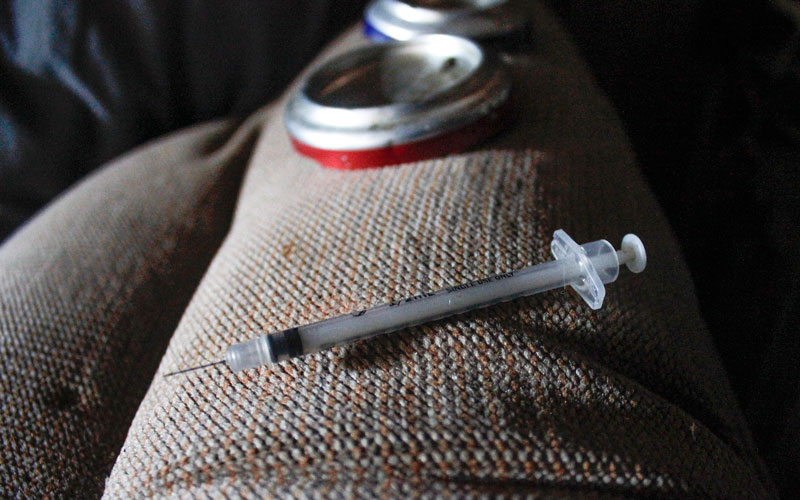
A syringe used to shoot heroin rests on a sofa in a Yuma dopehouse in this 2013 file photo. The White House wants to add $1.1 billion to the budget in fiscal 2017 to fight heroin and opioid abuse. (Photo by Danielle Grobmeier/Cronkite News)
WASHINGTON – The White House said Tuesday that it will include an additional $1.1 billion in its fiscal 2017 budget request to help states battle prescription opioid abuse and heroin use.
While administration officials did not detail where the money would go, the announcement was welcomed by at least one treatment official in Arizona, who said the state is “still deep in the fight” of an epidemic that “stretches from prescription pill misuse and abuse to heroin.”
That was echoed by Maricopa County Department of Public Health Director Bob England, who called the increase in funding “absolutely necessary.”
The Arizona Department of Health Services said heroin-related deaths have increased 93 percent since 2010 and hospitalizations have increased 41 percent. The agency estimates that prescribed opioid pain relievers were a factor in as many as 372 of the 1,132 drug overdose deaths in 2014.
Read more:
See Cronkite News’ award-winning coverage of the addiction epidemic that threatens a generation of young people, their families and friends, in “Hooked: Tracking Heroin’s Hold on Arizona.”
Tomi St. Mars, chief of the state health department’s Office of Injury Prevention, said prescription abuse and heroin use have been an issue in the state since the 1990s.
“We believe, in part, the spike in opioid addiction came from over-prescribing,” St. Mars said. “Now we’re trying to back down and prescribe mindfully.”
England said Maricopa County also saw what he called a tendency by doctors to over-prescribe, which led to an increase in opioid dependency. He said heroin addiction often comes after patients can no longer receive or fill prescriptions and turn to a cheaper, more dangerous – and illegal – alternative.
“In our county, docs prescribed enough opioid pain relievers to medicate every single adult for more than two weeks around the clock,” England said. “It’s no wonder that a large number of people have become dependent.”
St. Mars said the state department is part of the Arizona Prescription Drug Misuse and Abuse Initiative, which was started in 2012 after the number of deaths from opioid poisoning outnumbered those from motor vehicle accidents.
The state health department declined to comment directly on the White House plan, but at least one advocate said the announcement is long overdue.
“There is no question that we are still deep in the fight of an opioid epidemic that stretches from prescription pill misuse and abuse to heroin,” said Kristen Polin, vice president of programs at notMYkid, a substance-abuse prevention organization in the Valley.
In a conference call to unveil the White House proposal Tuesday, Health and Human Services Secretary Sylvia Mathews Burwell said that opioid abuse is a “complicated problem” that affects different types of people. The extra funding included in next year’s budget request would help close what she called a “significant treatment gap across the country.”
Michael Botticelli, the White House director of National Drug Control Policy, said on the call that the administration’s plan will turn the focus toward increased access to treatment.
The plan calls for $920 million of the $1.1 billion to go to states for use in “medication-assisted treatment for opioid use disorders,” with the money going to states with the greatest need and the strongest plans. The White House proposal said states could use the money to “expand treatment capacity and make services more affordable.”
Another $50 million would go to substance-abuse treatment providers, and $30 million would be available to evaluate the effectiveness of medication-assisted treatment programs.
Polin said the money acknowledges the need for a comprehensive approach to a complex problem.
“The most encouraging news released today demonstrates that we are finally recognizing the importance of investing in a comprehensive prevention and treatment solution,” she said.
– Cronkite News reporters Marisela Ramirez and Samantha Witherwax contributed to this report.